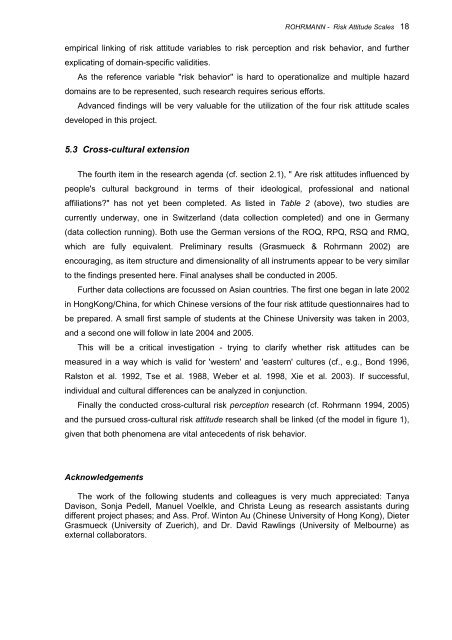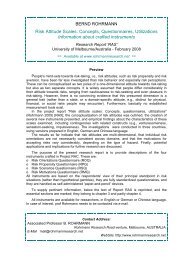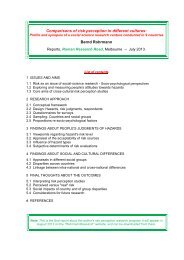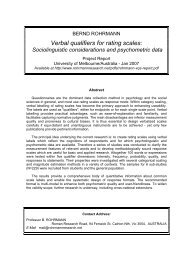Risk Attitude Scales: Concepts, Questionnaires, Utilizations
Risk Attitude Scales: Concepts, Questionnaires, Utilizations
Risk Attitude Scales: Concepts, Questionnaires, Utilizations
Create successful ePaper yourself
Turn your PDF publications into a flip-book with our unique Google optimized e-Paper software.
ROHRMANN - <strong>Risk</strong> <strong>Attitude</strong> <strong>Scales</strong> 18<br />
empirical linking of risk attitude variables to risk perception and risk behavior, and further<br />
explicating of domain-specific validities.<br />
As the reference variable "risk behavior" is hard to operationalize and multiple hazard<br />
domains are to be represented, such research requires serious efforts.<br />
Advanced findings will be very valuable for the utilization of the four risk attitude scales<br />
developed in this project.<br />
5.3 Cross-cultural extension<br />
The fourth item in the research agenda (cf. section 2.1), " Are risk attitudes influenced by<br />
people's cultural background in terms of their ideological, professional and national<br />
affiliations?" has not yet been completed. As listed in Table 2 (above), two studies are<br />
currently underway, one in Switzerland (data collection completed) and one in Germany<br />
(data collection running). Both use the German versions of the ROQ, RPQ, RSQ and RMQ,<br />
which are fully equivalent. Preliminary results (Grasmueck & Rohrmann 2002) are<br />
encouraging, as item structure and dimensionality of all instruments appear to be very similar<br />
to the findings presented here. Final analyses shall be conducted in 2005.<br />
Further data collections are focussed on Asian countries. The first one began in late 2002<br />
in HongKong/China, for which Chinese versions of the four risk attitude questionnaires had to<br />
be prepared. A small first sample of students at the Chinese University was taken in 2003,<br />
and a second one will follow in late 2004 and 2005.<br />
This will be a critical investigation - trying to clarify whether risk attitudes can be<br />
measured in a way which is valid for 'western' and 'eastern' cultures (cf., e.g., Bond 1996,<br />
Ralston et al. 1992, Tse et al. 1988, Weber et al. 1998, Xie et al. 2003). If successful,<br />
individual and cultural differences can be analyzed in conjunction.<br />
Finally the conducted cross-cultural risk perception research (cf. Rohrmann 1994, 2005)<br />
and the pursued cross-cultural risk attitude research shall be linked (cf the model in figure 1),<br />
given that both phenomena are vital antecedents of risk behavior.<br />
Acknowledgements<br />
The work of the following students and colleagues is very much appreciated: Tanya<br />
Davison, Sonja Pedell, Manuel Voelkle, and Christa Leung as research assistants during<br />
different project phases; and Ass. Prof. Winton Au (Chinese University of Hong Kong), Dieter<br />
Grasmueck (University of Zuerich), and Dr. David Rawlings (University of Melbourne) as<br />
external collaborators.





